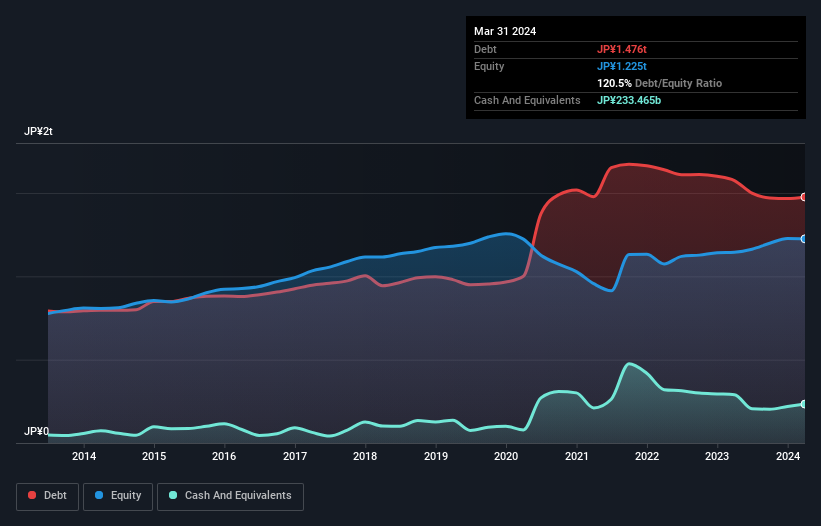
Warren Buffett famously said, 'Volatility is far from synonymous with risk.' So it might be obvious that you need to consider debt, when you think about how risky any given stock is, because too much debt can sink a company. Importantly, West Japan Railway Company (TSE:9021) does carry debt. But the more important question is: how much risk is that debt creating?
What Risk Does Debt Bring?
Debt assists a business until the business has trouble paying it off, either with new capital or with free cash flow. In the worst case scenario, a company can go bankrupt if it cannot pay its creditors. However, a more usual (but still expensive) situation is where a company must dilute shareholders at a cheap share price simply to get debt under control. Having said that, the most common situation is where a company manages its debt reasonably well - and to its own advantage. When we examine debt levels, we first consider both cash and debt levels, together.
See our latest analysis for West Japan Railway
How Much Debt Does West Japan Railway Carry?
The image below, which you can click on for greater detail, shows that West Japan Railway had debt of JP¥1.48t at the end of March 2024, a reduction from JP¥1.57t over a year. However, it also had JP¥233.5b in cash, and so its net debt is JP¥1.24t.

How Strong Is West Japan Railway's Balance Sheet?
The latest balance sheet data shows that West Japan Railway had liabilities of JP¥710.2b due within a year, and liabilities of JP¥1.84t falling due after that. Offsetting this, it had JP¥233.5b in cash and JP¥224.7b in receivables that were due within 12 months. So its liabilities total JP¥2.09t more than the combination of its cash and short-term receivables.
Given this deficit is actually higher than the company's market capitalization of JP¥1.55t, we think shareholders really should watch West Japan Railway's debt levels, like a parent watching their child ride a bike for the first time. Hypothetically, extremely heavy dilution would be required if the company were forced to pay down its liabilities by raising capital at the current share price.
We use two main ratios to inform us about debt levels relative to earnings. The first is net debt divided by earnings before interest, tax, depreciation, and amortization (EBITDA), while the second is how many times its earnings before interest and tax (EBIT) covers its interest expense (or its interest cover, for short). The advantage of this approach is that we take into account both the absolute quantum of debt (with net debt to EBITDA) and the actual interest expenses associated with that debt (with its interest cover ratio).
West Japan Railway has a debt to EBITDA ratio of 3.6, which signals significant debt, but is still pretty reasonable for most types of business. However, its interest coverage of 10.3 is very high, suggesting that the interest expense on the debt is currently quite low. Notably, West Japan Railway's EBIT launched higher than Elon Musk, gaining a whopping 111% on last year. There's no doubt that we learn most about debt from the balance sheet. But it is future earnings, more than anything, that will determine West Japan Railway's ability to maintain a healthy balance sheet going forward. So if you're focused on the future you can check out this free report showing analyst profit forecasts.
Finally, while the tax-man may adore accounting profits, lenders only accept cold hard cash. So we clearly need to look at whether that EBIT is leading to corresponding free cash flow. In the last two years, West Japan Railway's free cash flow amounted to 36% of its EBIT, less than we'd expect. That weak cash conversion makes it more difficult to handle indebtedness.
Our View
We feel some trepidation about West Japan Railway's difficulty level of total liabilities, but we've got positives to focus on, too. For example, its EBIT growth rate and interest cover give us some confidence in its ability to manage its debt. When we consider all the factors discussed, it seems to us that West Japan Railway is taking some risks with its use of debt. So while that leverage does boost returns on equity, we wouldn't really want to see it increase from here. When analysing debt levels, the balance sheet is the obvious place to start. However, not all investment risk resides within the balance sheet - far from it. For example, we've discovered 2 warning signs for West Japan Railway that you should be aware of before investing here.
Of course, if you're the type of investor who prefers buying stocks without the burden of debt, then don't hesitate to discover our exclusive list of net cash growth stocks, today.
Valuation is complex, but we're here to simplify it.
Discover if West Japan Railway might be undervalued or overvalued with our detailed analysis, featuring fair value estimates, potential risks, dividends, insider trades, and its financial condition.
Access Free AnalysisHave feedback on this article? Concerned about the content? Get in touch with us directly. Alternatively, email editorial-team (at) simplywallst.com.
This article by Simply Wall St is general in nature. We provide commentary based on historical data and analyst forecasts only using an unbiased methodology and our articles are not intended to be financial advice. It does not constitute a recommendation to buy or sell any stock, and does not take account of your objectives, or your financial situation. We aim to bring you long-term focused analysis driven by fundamental data. Note that our analysis may not factor in the latest price-sensitive company announcements or qualitative material. Simply Wall St has no position in any stocks mentioned.
About TSE:9021
Proven track record second-rate dividend payer.
Market Insights
Community Narratives



